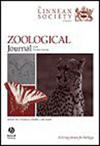Evolution of different adaptations for pollen uptake from flowers of Heliotropium (Boraginaceae) with narrow corolla tube in pollen wasps of the genus Celonites (Hymenoptera: Vespidae: Masarinae)
IF 3
2区 生物学
Q1 ZOOLOGY
引用次数: 0
Abstract
The evolution of flower-visiting behaviour in pollen wasps remains poorly investigated. The females of oligolectic Celonites species show two fundamentally different behavioural patterns for pollen uptake from Heliotropium flowers with a narrow corolla tube. They remove pollen from the concealed anthers either with their forelegs or with their proboscis. Single-frame video analysis revealed that pollen collection with the proboscis consists of a hitherto unknown, unique, and stereotypic behavioural pattern. The first phylogenetic reconstruction of Celonites based on ultra-conserved elements demonstrates that this highly complex behaviour is presumably homologous and evolved only once. It probably derived from accidental consumption of pollen adhering to the proboscis during nectar uptake and is associated with morphological adaptations of the foretarsi and mouthparts. Pollen uptake with the forelegs evolved independently. Morphological adaptations to this type of pollen uptake are the elongation of the forelegs and a tarsal pollen brush formed by hooked setae. These results confirm for pollen wasps a view that has been developed in studies of bee–flower relationships, namely that pollen collection, contrary to nectar collection, is a specific and stereotypic behaviour that often requires morphological and behavioural adaptations, possibly underlying the high rate of specialization observed in pollen-collecting Hymenoptera.窄花冠管花球蜂属花粉黄蜂对花冠管窄花冠蜂花粉摄取的不同适应性进化(膜翅目:蜂科:蜂科)
花粉黄蜂访花行为的进化仍未得到充分的研究。少聚堇属植物的雌性从窄花冠筒的Heliotropium花中摄取花粉表现出两种根本不同的行为模式。它们用前腿或喙从隐藏的花药中取出花粉。单帧视频分析显示,用喙采集花粉是一种迄今为止未知的、独特的、刻板的行为模式。基于超保守元素的第一次Celonites系统发育重建表明,这种高度复杂的行为可能是同源的,并且只进化了一次。这可能是由于在花蜜摄取过程中偶然消耗了附着在喙上的花粉,并与前肢和口器的形态适应有关。前腿的花粉摄取是独立进化的。对这种花粉摄取类型的形态适应是前肢的伸长和钩状刚毛形成的跗状花粉刷。这些结果证实了花粉黄蜂在蜂花关系研究中发展起来的观点,即花粉收集与花蜜收集相反,是一种特定的和刻板的行为,通常需要形态和行为适应,这可能是在膜翅目昆虫中观察到的高专一化率的基础。
本文章由计算机程序翻译,如有差异,请以英文原文为准。
求助全文
约1分钟内获得全文
求助全文
来源期刊
CiteScore
6.50
自引率
10.70%
发文量
116
审稿时长
6-12 weeks
期刊介绍:
The Zoological Journal of the Linnean Society publishes papers on systematic and evolutionary zoology and comparative, functional and other studies where relevant to these areas. Studies of extinct as well as living animals are included. Reviews are also published; these may be invited by the Editorial Board, but uninvited reviews may also be considered. The Zoological Journal also has a wide circulation amongst zoologists and although narrowly specialized papers are not excluded, potential authors should bear that readership in mind.

 求助内容:
求助内容: 应助结果提醒方式:
应助结果提醒方式:


